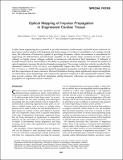| dc.contributor.author | Radisic, Milica | |
| dc.contributor.author | Fast, Vladimir G. | |
| dc.contributor.author | Sharifov, Oleg F. | |
| dc.contributor.author | Iyer, Rohin K. | |
| dc.contributor.author | Park, Hyoungshin | |
| dc.contributor.author | Vunjak-Novakovic, Gordana | |
| dc.date.accessioned | 2011-04-14T18:55:09Z | |
| dc.date.available | 2011-04-14T18:55:09Z | |
| dc.date.issued | 2009-07 | |
| dc.date.submitted | 2008-04 | |
| dc.identifier.issn | 1937-3341 | |
| dc.identifier.issn | 1937-335X | |
| dc.identifier.uri | http://hdl.handle.net/1721.1/62206 | |
| dc.description.abstract | Cardiac tissue engineering has a potential to provide functional, synchronously contractile tissue constructs for heart repair, and for studies of development and disease using in vivo–like yet controllable in vitro settings. In both cases, the utilization of bioreactors capable of providing biomimetic culture environments is instrumental for supporting cell differentiation and functional assembly. In the present study, neonatal rat heart cells were cultured on highly porous collagen scaffolds in bioreactors with electrical field stimulation. A hallmark of excitable tissues such as myocardium is the ability to propagate electrical impulses. We utilized the method of optical mapping to measure the electrical impulse propagation. The average conduction velocity recorded for the stimulated constructs (14.4 ± 4.1 cm/s) was significantly higher than that of the nonstimulated constructs (8.6 ± 2.3 cm/s, p = 0.003). The measured electrical propagation properties correlated to the contractile behavior and the compositions of tissue constructs. Electrical stimulation during culture significantly improved amplitude of contractions, tissue morphology, and connexin-43 expression compared to the nonsimulated controls. These data provide evidence that electrical stimulation during bioreactor cultivation can improve electrical signal propagation in engineered cardiac constructs. | en_US |
| dc.description.sponsorship | Natural Sciences and Engineering Research Council of Canada (Discovery Grant) | en_US |
| dc.description.sponsorship | National Institutes of Health (U.S.) (R01 HL076485) | en_US |
| dc.description.sponsorship | National Institutes of Health (U.S.) (P41-EB002520) | en_US |
| dc.description.sponsorship | Ontario Graduate Scholarship | en_US |
| dc.language.iso | en_US | |
| dc.publisher | Mary Ann Liebert, Inc. | en_US |
| dc.relation.isversionof | http://dx.doi.org/10.1089/ten.tea.2008.0223 | en_US |
| dc.rights | Article is made available in accordance with the publisher's policy and may be subject to US copyright law. Please refer to the publisher's site for terms of use. | en_US |
| dc.source | Mary Ann Liebert | en_US |
| dc.title | Optical Mapping of Impulse Propagation in Engineered Cardiac Tissue | en_US |
| dc.type | Article | en_US |
| dc.identifier.citation | Radisic, Milica et al. “Optical Mapping of Impulse Propagation in Engineered Cardiac Tissue.” Tissue Engineering Part A 15.4 (2009) : 851-860. ©2009 Mary Ann Liebert, Inc. | en_US |
| dc.contributor.department | Harvard University--MIT Division of Health Sciences and Technology | en_US |
| dc.contributor.department | Massachusetts Institute of Technology. Department of Chemical Engineering | en_US |
| dc.contributor.approver | Park, Hyoungshin | |
| dc.contributor.mitauthor | Park, Hyoungshin | |
| dc.relation.journal | Tissue Engineering. Part A | en_US |
| dc.eprint.version | Final published version | en_US |
| dc.type.uri | http://purl.org/eprint/type/JournalArticle | en_US |
| eprint.status | http://purl.org/eprint/status/PeerReviewed | en_US |
| dspace.orderedauthors | Radisic, Milica; Fast, Vladimir G.; Sharifov, Oleg F.; Iyer, Rohin K.; Park, Hyoungshin; Vunjak-Novakovic, Gordana | en |
| mit.license | PUBLISHER_POLICY | en_US |
| mit.metadata.status | Complete | |
